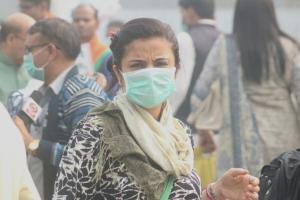The CPCB emphasized the need for proactive actions by concerned agencies to control air pollution in the industrial areas and 18 areas in Delhi have been identified on a priority basis

The weather agency noted that the air quality index is still much better than that of last few years in this time of the year. Picture/Twitter IANS
The worsening air quality in Delhi has now firmly entered the poor category with an overall air quality index (AQI) score of 266 on Sunday with the only consolation being that pollution is not as bad as that of previous years.
ADVERTISEMENT
The worsening air quality in #Delhi has now firmly entered the poor category with an overall air quality index (#AQI) score of 266 on October 13 with the only consolation being that pollution is not as bad as that of previous years.
— IANS Tweets (@ians_india) October 13, 2019
Photo: IANS pic.twitter.com/aN3WeM2TO1
According to pollution watch by Safar (System of Air Quality and Weather Forecasting and Research) India, developed by the Ministry of Earth Science and Indian Institute of Tropical Meteorology, Pune, the overall air quality of Delhi is in the poor category and the increased biomass fire activity in Haryana and Panjab may now start to influence Delhi's AQI. The PM 2.5 count was at 110 falling in the poor category while the PM 10 count stood at a score of 201, falling under the moderate category.
However, the share of external bio-mass fires in total PM 2.5 computation as of now is just around 2 per cent, according to Safar, which has now included this as a new variable.
The bulletin noted that the surface wind speed continues to be slow and variable with predominant direction from the West. "Under these conditions, air quality is predicted to deteriorate to the middle of the poor category by Monday. Further deterioration of the AQI is expected by October 14 but within the poor category", the forecast said.
However, the weather agency noted that the air quality index is still much better than that of last few years in this time of the year, partly due to enough widespread moisture with relatively warmer temperature around surrounding areas of Delhi.
The Central Pollution Control Board (CPCB) held a meeting recently with industrial stakeholders to discuss the action plan for Delhi NCR during upcoming winter. The CPCB emphasized the need for proactive actions by concerned agencies to control air pollution in the industrial areas and 18 areas in Delhi have been identified on a priority basis.
The priority areas are Anand Vihar, Ashok Vihar, Vivek Vihar, Punjabi Bagh, Wazirpur, R K Puram, Mundka, Narela, Bawana, Dwarka, Okhla Phase II, Jahangirpuri, Rohini, Mayapuri, Faridabad, Faridabad 2, Sahibabad and Udyog Vihar.
It was pointed out to the stakeholders that unpaved roads, industrial emissions, waste burning, and heavy commercial vehicles are major sources of pollution in these areas. The plan of action included micro level, area specific action plan for unpaved roads, dumping of waste and heavy vehicles.
A mechanism will be set up for coordinated actions by concerned agencies, industries association and other stakeholders and the state pollution control board may act as nodal agency. It has also been decided to carry out joint day and night patrolling and monitoring in high emissions areas on a regular basis by SPCBs and concerned agencies.
Catch up on all the latest sports news and updates here. Also download the new mid-day Android and iOS apps to get latest updates
 Subscribe today by clicking the link and stay updated with the latest news!" Click here!
Subscribe today by clicking the link and stay updated with the latest news!" Click here!







